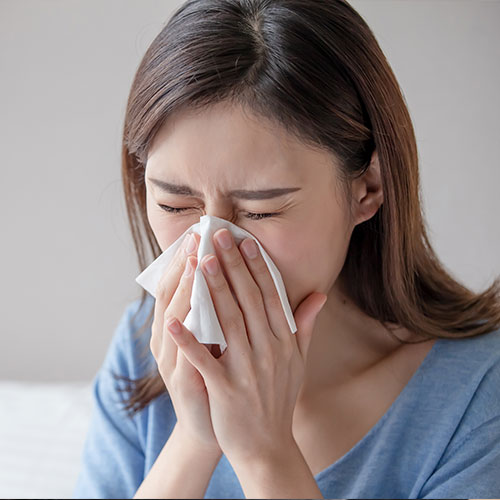Sneezing with fever, stuffy nose, headache, body aches, and sore throat – how do you know if it is just a common cold? Sharing the same set of symptoms, it’s easy to mistake common cold from flu or COVID. However, despite all three being respiratory infections caused by different viruses, they trigger different health concerns that require different ways for treatment. Read on to learn about these conditions, and more importantly, how you can tell one from the other.
Common Cold, Flu and COVID 101
Why is it important to determine whether what you have is a cold or flu or COVID? In general, identifying your condition is the first step to treatment and preventing the spread of infection at home or in the workplace. Before you can solve a problem, you need to know what you’re dealing with. And with cold, flu and COVID, these quick facts are good to know.
- Common Cold
The common cold is called ‘common’ due to the fact that there are more than 200 different viruses that can cause it. Of these viruses, the highly contagious rhinovirus is most often the culprit behind the sudden sneezes and sniffles.
Contrary to the belief that you can only catch colds during the rainy season, you can have it at any time of the year. It’s only more common in the colder months as most viruses thrive in low humidity. It is transferred or spread through contact with respiratory droplets released when someone breathes, coughs, sneezes, talks or sings, or by touching any surface that the infected person has touched. - Influenza (Flu)
Mostly caused by influenza A and B viruses, flu is also reported all year round though more cases are seen in the Philippines from June to August. It spreads the same way that a cold does: through contact with respiratory droplet of someone who’s infected.
While the common cold can be limiting yet harmless, flu can develop into serious concerns such as pneumonia for young children, older adults, pregnant women and people with conditions that affect their immunity. - COVID-19
Caused by coronavirus which was first identified in 2019. It spreads more easily than flu or common colds and may cause more serious illness especially among the elderly and those with comorbidities.
A Cheat Sheet on the Symptoms
While they share the same set, the symptoms of COVID, flu and cold vary in terms of nature of onset, and intensity. Cold symptoms tend to be gradual and milder; while for flu and COVID, symptoms are usually abrupt and severe. Check out this quick guide, sourced from the National Institute of Aging of the U.S.’ National Institutes of Health:
| Symptoms | Cold | Flu | COVID-19 |
|---|---|---|---|
| Fever and/or chills | ✔ | ✔ | |
| Headache | ✔ | ✔ | |
| Body aches and/or muscle pain | ✔ | ✔ | |
| Fatigue and/or weakness | ✔ | ✔ | |
| Shortness of breath or breathing difficulties | ✔ | ✔ | |
| Vomiting and diarrhea | ✔ | ✔ | |
| Sneezing | ✔ | ||
| Cough | ✔ | ✔ | ✔ |
| Stuffy or runny nose | ✔ | ✔ | ✔ |
| Sore throat | ✔ | ✔ | ✔ |
| Changes in or loss of sense of taste and smell | ✔ |
So, is it a cold or a flu or COVID? This guide clues you in. However, given that we are still in the COVID pandemic, it is recommended to immediately isolate when any of the symptoms develop then set an appointment for a telemedicine consult or at the clinic or health center. It is only by doing a test such as rapid antigen or RT-PCR that one respiratory infection can be differentiated from the other.
Cold, Flu or COVID, Here’s What You Can Do
Once you’re sure with what condition it is that you’re dealing with, you can now find effective ways to tame or manage the symptoms. For all conditions, taking a rest, taking plenty of fluids and eating immune-boosting foods can do wonders.
Although they share the same symptoms, medications for COVID, flu and cold vary, depending on the discomforts you are experiencing. Here’s a quick list of terms you need to be acquainted with when looking for an over-the-counter medicine:
- Analgesics – best for fever and pain reduction
- Antihistamines – blocking the effects of histamines, antihistamines target itching and sneezing that usually come with an allergic reaction
- Decongestants – cuts down on the fluid within the nose, helping ease swollen passages and congestion
- Nasal steroids – helps with runny nose or sinus pressure
- Expectorants – helps you clear mucus or phlegm from your airways
- Antitussives – helps suppress coughs
On top of these medications, your doctor may prescribe antiviral drugs for flu or COVID. These help shorten the duration of the infection while also preventing complications. Keep in mind that there are vaccines available to help prevent catching flu or COVID.
Sources:
https://www.cdc.gov/flu/symptoms/coldflu.htm
https://www.healthline.com/health/cold-flu/cold-or-flu
https://ololrmc.com/blogs/making-sense-of-symptoms
https://www.everydayhealth.com/flu/guide/
https://stacks.cdc.gov/view/cdc/43638/cdc_43638_DS1.pdf
https://www.lung.org/lung-health-diseases/lung-disease-lookup/influenza/facts-about-the-common-cold
https://www.webmd.com/allergies/antihistamines-1
https://www.nia.nih.gov/health/infographics/it-cold-flu-or-covid-19








